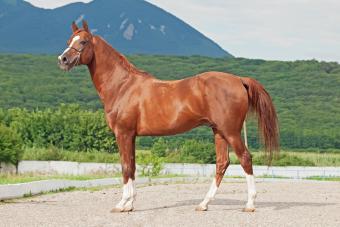
The notion that horses sleep standing up may sound like a myth, but it far from a tall tale. Thanks to an unusual anatomical mechanism, horses can catch their Zzzs while in an upright position. But that's not the only way they rest their bodies.
How Do Horses Sleep?
The short answer is that horses sleep both standing up and laying down. Horses nap in a standing position yet obtain their deep sleep just as you do, while laying and relaxed -- the explanation of why and how they do this is more complex.
Survival Sleep Patterns
Because horses are prey creatures, they must be ready to flee from various predators at any time of the day or night. As a result, the species has a strategic, evolutionary system in place to keep each horse in the herd both well-rested and safe. They essentially sleep in shifts to ensure that one member can watch for approaching danger.
REM Sleep
Rapid eye movement (REM) sleep is the deepest sleep state. Without the appropriate amount of REM, a horse's mental and physical health may be compromised. The only way horses can get this deep REM sleep is when their entire body is relaxed. For this to happen, they must lie down.
But we don't typically see horses sprawled out in deep sleep because they don't need much of it. Adult horses require about 30 minutes of REM sleep each day, and they obtain it in several short intervals. However, a horse will only lie down for a few minutes of shut-eye if they feel safe.
Light Sleep
Horses nap in a standing position. They do this so they can be ready to run from predators while still allowing their bodies and minds to rest. Although this light sleep is not as restful as the REM sleep obtained while laying down, it is still important.
Locking Joint Abilities
Sleeping while standing might sound dangerous, but horses have a uniquely developed structural system that allows them to do so safely. This mechanism is called the stay apparatus, whereby they can lock their joints in place. The stay apparatus allows horses to stand for extended periods without exhausting their muscles. But horses don't necessarily lock all four limbs continuously. Instead, they may slightly hold up one limb and allow it to relax completely to rest the muscles while the others remain locked.
Sleep Requirements Based on Age
An adult horse needs a total of three to five hours of sleep each day. This includes a minimum of 30 minutes of REM sleep, with the rest consisting of light naps. However, foals require more. It's not unusual for newborns and young foals to sleep for 8 to 12 hours of the day. And much of this rest is laterally recumbent REM sleep. But as a foal grows, their needs change, and they spend more time in standing rest and less laying down.
The Final Verdict
The answer to the question of whether horses sleep standing up is both yes and no. It's important to understand that horses do need to lay down for REM sleep. Therefore, horse owners should provide adequate space for their equine companions to get into a laying position comfortably and safely. Without this deep, restful sleep, a horse can suffer from negative physical and mental health consequences.







